Great Mosque of Xi'an
The Great Mosque of Xi'an (Chinese: 西安大清真寺; pinyin: Xī Ān Dà Qīng Zhēn Sì) is the largest mosque in China.[1][2][3]:128 It was first built in the year 742 AD.[4] An active place of worship within Xi'an Muslim Quarter,[5] this courtyard complex is also a popular tourist site. The majority of the mosque was built during the early Ming dynasty.[6]:121 It now houses more than twenty buildings in its five courtyards, and covers 12,000 square metres.
| مسجد شيان Great Mosque of Xi'an | |
|---|---|
西安大清真寺 Xī Ān Dà Qīng Zhēn Sì | |
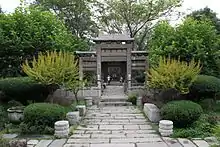 Second courtyard of the Great Mosque | |
| Religion | |
| Affiliation | Sunni Islam |
| Location | |
| Location | Xi'an, Shaanxi |
| Geographic coordinates | 34°15′47.9″N 108°56′11.0″E |
| Architecture | |
| Type | Mosque |
| Style | Chinese |
| Site area | 12,000 m2 |
Etymology
The mosque is also known as the Huajue Mosque (Chinese: 化觉巷清真寺; pinyin: Huà Jué Xiàng Qīng Zhēn Sì),[1][2] for its location on 30 Huajue Lane. It is sometimes called the Great Eastern Mosque (Chinese: 东大寺; pinyin: Dōng Dà Sì), as well, because it sits east of another of Xi’an's oldest mosques, Daxuexi Alley Mosque (Chinese: 大学习巷清真寺; pinyin: Dà Xué Xí Xiàng Qīng Zhēn Sì).[2]
History
The mosque was constructed during the Hongwu reign of the Ming dynasty, with further additions during the Qing dynasty.[6]:121 Previous religious complexes (Tanmingsi and Huihui Wanshansi) are known to have stood on the same site, dating to as early as the Tang dynasty.[6]:121
Islam was introduced to China during the Ming Dynasty in the seventeenth century, but went into full effect during the Qing Dynasty in 1644. When trying to integrate the different groups of people, people would gravitate more towards Chinese tradition due to feelings of superiority. During the 1700s, Muslim freedom of worship was limited, the ritual slaughtering of animals were forbidden, new mosques and the pilgrimage to Mecca was prohibited in the year 1731. [7]
After the Chinese Communist Party won the Chinese Civil War the Mosque was shut down and converted into a steel factory.[8]
In 1956, the mosque was declared a Historical and Cultural Site Protected at the Shaanxi Province Level, and was later promoted to a Major Historical and Cultural Site Protected at the National Level in 1988.
The mosque is still used as a place of worship by Chinese Muslims, primarily Hui people. Just the main hall of the Great Mosque of Xi’an can accommodate 1,000 people yet today a typical service only attracts around 100.[9]
In 1997, it was selected as one of the top 10 tourist attractions in Xi'an.
Architecture
The mosque is a walled complex of four courtyards, with the prayer hall located in the fourth courtyard. Each courtyard contains a central monument, such as a gate, and is lined with greenery as well as subsidiary buildings. The first courtyard, for instance, contains a Qing dynasty monumental gate, while the fourth courtyard houses the Phoenix Pavilion, a hexagonal gazebo. Many walls throughout the complex are filled with inscriptions of birds, plants, objects, and text, both in Chinese and Arabic. Stone steles record repairs to the mosque and feature calligraphic works. In the second courtyard, two steles feature scripts of the calligrapher Mi Fu of the Song dynasty and Dong Qichang, a calligrapher of the Ming dynasty.
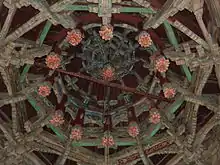
The Xingxin Tower is located in the third courtyard, which contains many steles form ancient times. This courtyard is for visitors to attend prayer services. The fourth courtyard has a bigger prayer hall which can seat more than a thousand people. [10]
Overall, the mosque's architecture, like the majority of Hui Chinese mosques, combines a traditional Chinese architectural form with Islamic functionality. For example, whereas traditional Chinese buildings align along a north–south axis in accordance with feng shui, the mosque is directed west towards Mecca,[2] while still conforming to the axes of the imperial city. Furthermore, calligraphy in both Chinese and Arabic writing appears throughout the complex, sometimes exhibiting a fusion of styles called Sini, referring to Arabic text written in Chinese-influenced script. Some scholars also speculate that the three-story, octagonal pagoda in the third courtyard, called the Shengxinlou or “Examining the Heart Tower,” originally served as the mosque's minaret, used for the call to prayer.[11]:346
The prayer hall is a monumentally sized timber building with a turquoise hip roof, painted dougong (wooden brackets), a six-pillared portico, and five doors. It is raised upon a large stone platform lined with balustrades. The expansive prayer hall consists of three conjoined buildings, set one behind the other. Interior ornamentation is centered on the rear qibla wall, which has wooden carvings of floral and calligraphic designs.[5]
Gallery
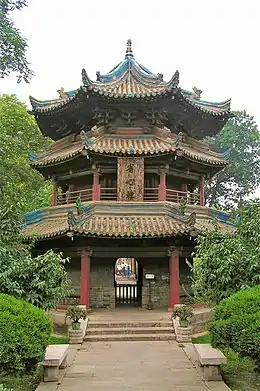 “Examining the Heart Tower” in the third courtyard
“Examining the Heart Tower” in the third courtyard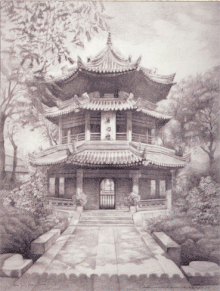 Wahbi Al-Hariri's graphite drawing of the Great Mosque of Xi'an
Wahbi Al-Hariri's graphite drawing of the Great Mosque of Xi'an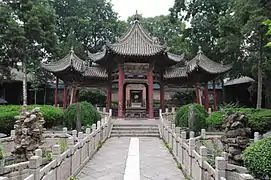 Phoenix Pavilion in the fourth courtyard
Phoenix Pavilion in the fourth courtyard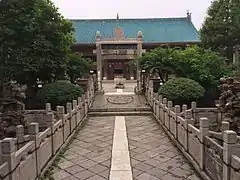 Facing the prayer hall of the Great Mosque of Xi'an, in the fourth courtyard
Facing the prayer hall of the Great Mosque of Xi'an, in the fourth courtyard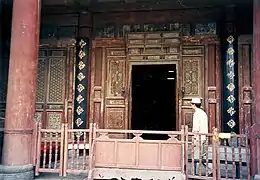 Entrance to the prayer hall
Entrance to the prayer hall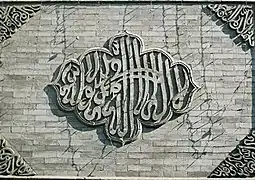 Calligraphy on a plaque in the Great Mosque of Xi'an
Calligraphy on a plaque in the Great Mosque of Xi'an
See also
References
- Hagras, Hamada (2017). "An Ancient Mosque in Ningbo, China "Historical and Architectural Study"". Journal of Islamic Architecture. 4 (3): 102–113. doi:10.18860/jia.v4i3.3851.
- Hagras, Hamada (Summer 2019). "Xi'an Daxuexi Alley Mosque: Historical and Architectural Study". Egyptian Journal of Archaeological and Restoration Studies. 9 (1): 97–113. doi:10.21608/ejars.2019.38462.
- Liu, Zhiping (1985). Zhongguo Yisilanjiao jianzhu [Islamic architecture in China]. Xinjiang Renmin Chubanshe.
- "Great Mosque, Xi'an: One of the Oldest & Best-Protected Mosque in China". www.travelchinaguide.com. Retrieved 2020-07-15.
- Hagras, Hamada (2019). "The Ming Court as patron of the Chinese Islamic architecture: The case study of The Daxuexi Mosque in Xi'an". SHEDET. 6 (6): 134–158. doi:10.36816/shedet.006.08.
- Steinhardt, Nancy S. (2015). China's Early Mosques. Edinburgh University Press. ISBN 978-0748670413.
- Israeli, Raphael (2002). Islam in China. 4720 Boston Way, Lanham, Maryland: Lexington Books. p. 7. ISBN 0-7391-0375-X.CS1 maint: location (link)
- Chen, Xiaomei. "China's Muslims fear crackdown in ancient city of Xi'an". The Guardian.
- Salahuddin, Iftikhar. "The ancient mosque of X'ian". www.dawn.com. Dawn. Retrieved 24 September 2019.
- Tang, Cindy. "Xi'an Great Mosque — the Largest Mosque in China". China Highlights.
- Steinhardt, Nancy S. (2008). "China's Earliest Mosques". Journal of the Society of Architectural Historians. 67 (3): 330–361. doi:10.1525/jsah.2008.67.3.330.
External links
| Wikimedia Commons has media related to Great Mosque of Xi'an. |